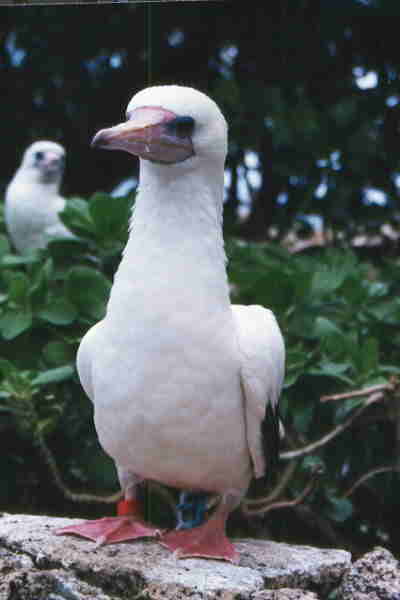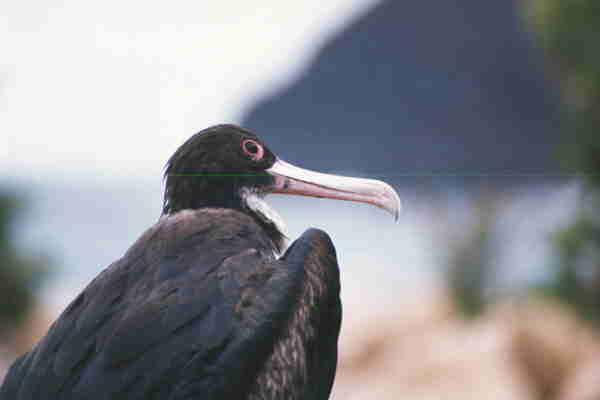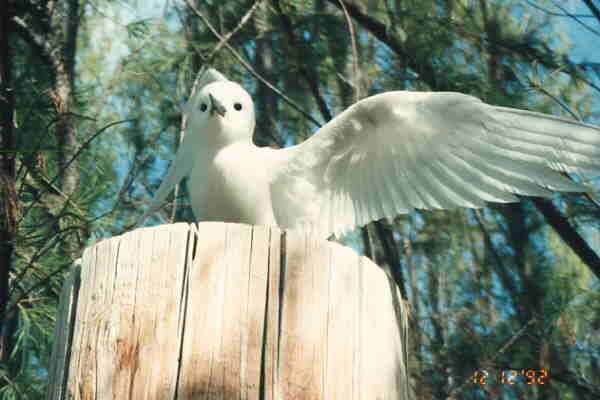ON FARALLON DE MEDINILLA
| Since October, 1971, the Island of Farallon de
Medinilla, home to frigate birds, boobies, terns, and
other species, as well as a remnant population of
humpback whales, has been used as a bombardment range by
the U.S. Navy and Air Force. LOCATION
Farallon de Medinilla is located within the Marianas
District at 16o 01' north latitude, 146o
04' east longitude, approximately
45 miles north-northeast of Saipan and 154 miles
north-northeast of the U.S. Territory of Guam. The island
is approximately 1.6 miles long and 0.25 miles wide. The
total land mass is .035 square miles, or 224 acres.
PAST NAVAL USE
|
 |
During the peak of the Vietnam War
bombing operations, the quantity of ordnance delivered on the
island was estimated at 22 tons per month. This consisted
primarily of air-dropped, 500 and 750-pound bombs. Also included
in the total monthly figure were approximately 60 rounds of
three-inch ammunition from ship guns.
In its February, 1975, Environmental
Impact Study, the Navy stated that "current and future use
of the Island calls for a reduced amount of ordnance delivery. It
is estimated that some 40 tons of aerial bombs per year will be
dropped, consisting of 500-pound and 750-pound bombs. It is
further expected that some 60 rounds per month of three-inch
ammunition will be fired at the island. The use of the missiles
is not expected to exceed four or five firings a year." Keep
these figures in mind as you read below about the amount of
ordnance used in 1997.
CURRENT NAVAL ACTION
The May 16, 1997, Biological Opinion
of the U.S. Fish and Wildlife Service for Gunnery and Aerial
Bombardment Practice at Farallon de Medinilla, Commonwealth of
the Northern Marian Islands states:
"The Navy proposes to engage in
gunnery practice during May, 1997, and aerial bombardment from
July 21 to August 1, 1997, on FDM, CNMI. The purpose of the
project is to allow Navy carrier aircraft and ships to
participate in aircraft carrier support training including
surface gunnery and bombing practice. Ships assigned to the
Seventh Fleet will conduct gunnery practice by firing an
estimated 200 5/54 live rounds. The most likely ammunition type
for the 5/54 will be high explosive with controlled variable time
fused rounds that produce fragmentation air burst as well as high
explosive point detonations. Navy fighter /attack aircraft
assigned to the Carrier Air Group will practice delivery of live
ordnance, consisting primarily of MK-80 series iron bombs which
are designed to explode on impact. A variety of other ordnance
may also be used. An estimated total of 135 MK-82 live 500 pound
(#) bombs, 50 MK-83 live 1000# bombs, 36 MK-84 live 2000# bombs,
180 BDU-4S inert bombs, and 984 MK-76 inert bombs will be
delivered by aircraft. It is possible that naval gunfire or
bombing will occur at night. The Navy will conduct both pre- and
post-exercise helicopter overflights to monitor training impacts
and assess take of threatened and endangered species for both the
May and July/August exercises."
WHY THIS SHOULD BE STOPPED
As recently as 1975, the Navy’s
Environmental Impact Study stated "The boobies nest as a
colony which is fairly evenly distributed over the vegetated top
of the island at a rate of about 100 nests to the acre. This
would indicate a population of 50,000 + ."
But, in a letter to the U.S. Fish and
Wildlife Service, dated April, 1996, in which the Navy requested
a permit to take birds during their live fire training exercises,
they stated that, for all three species of booby, they had
counted a total of 1400 birds.
In 1997 a survey by the U.S. Fish and
Wildlife Service found 4 Micronesian Megapodes, an endangered
species, yet the Navy was given a permit to take a total of 10
megapodes!
 |
Additional bombing operations
are planned for the future. Please check with us again
for further details. You can also write to President Clinton asking him to stop the destruction of
Farallon de Medinilla. Thank
you.
|
CLICK
HERE TO WRITE TO PRESIDENT CLINTON

Return to EnviroWatch


